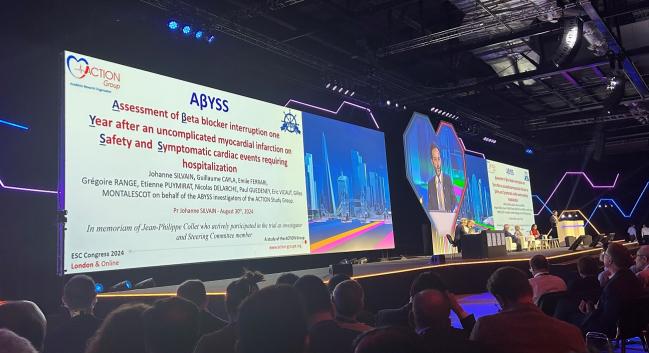ABYSS: Safety Signal Seen When Beta-blockers Stopped in Post-MI Patients
(UPDATED) The study failed to show that stopping beta-blockers after MI was noninferior to continuing treatment, surprising researchers.

LONDON, England—In a somewhat surprising finding, a randomized trial has shown that stopping beta-blockers in patients with a history of myocardial infarction might be harmful when compared with continued treatment.
In ABYSS, discontinuing beta-blocker therapy in patients several years after their MI failed to meet noninferiority criteria for the combined primary endpoint of all-cause mortality, nonfatal MI, nonfatal stroke, or cardiovascular hospitalizations when compared with ongoing treatment, investigators reported here Friday during the first Hot Line session at the European Society of Cardiology Congress 2024.
Stopping beta-blocker therapy also failed to improve quality of life, led to more hospitalizations for cardiovascular causes, including for angina, and resulted in higher heart rates and systolic and diastolic blood pressure.
Those findings were unexpected, said Johanne Silvain, MD (Sorbonne Université, Paris, France), given other recent data: ABYSS was designed with the idea that discontinuing beta-blockers would not only be safe, but would translate to an improved quality of life.
There’s no reason to stop beta-blocker therapy in post-MI patients who are tolerating the medications, he said.
“Knowing our results now, I would probably not stop a drug that is well tolerated [and whose] cost is quite low,” Silvain told TCTMD. “In people on chronic beta-blocker therapy, you’ve already selected [out] people who don’t tolerate the drug, so there’s not much benefit of stopping [in those on long-term treatment]. What we show here is that there’s a safety signal to stopping.”
Knowing our results now, I would probably not stop a drug that is well tolerated [and whose] cost is quite low. Johanne Silvain
Marc Bonaca, MD (University of Colorado School of Medicine, Denver), who wasn’t involved in the study, said ABYSS suggests there is benefit to continuing beta-blocker therapy in patients with a prior MI and preserved ejection fraction.
“What drove the benefit was hospitalizations for cardiovascular causes and angina, but even when you look at the point estimates for heart failure and myocardial infarction, they all go above 1 and it’s not a huge trial,” he told TCTMD. “So, I think the jury’s still out, but fortunately there are more trials coming that should help clarify the role for beta-blockers in this population.”
Like Silvain, Bonaca was surprised the trial found no benefit in the quality-of-life measure. “For patients that are on beta-blockers and tolerating them, I don’t think we should stop them,” he agreed.
The study was published simultaneously in the New England Journal of Medicine.
Long-term Beta-blockers After MI
Before ABYSS, studies have challenged the use of beta-blockers in the modern era of post-MI care. Earlier this year, the REDUCE-AMI investigators showed that long-term use of beta-blockers in patients with acute MI and preserved ejection fraction did nothing to reduce the risk of death or recurrent MI. Observational studies have yielded mixed results. Some, including REACH and CLARIFY, found no benefit of beta-blockers when given on top of contemporary medical therapy, while another showed that stopping beta-blockers beyond 1 year after acute MI was associated with an increased risk of mortality or readmission for ACS.
US guidelines recommend that physicians start beta-blockers in ACS patients with STEMI (class I recommendation, level of evidence B) and in NSTE ACS patients without impaired systolic function (class IIa, level of evidence C). However, the US guidelines for the management of chronic coronary disease, which were updated just last year, state that it’s reasonable to reassess the need for long-term beta-blocker use (beyond 1 year) in post-MI patients for reducing MACE (class IIb, level of evidence B).
The 2024 European guidelines for the management of chronic coronary syndrome—published Friday in the European Heart Journal—acknowledge that there is a gap in the evidence when it comes to the long-term benefit of beta-blocker therapy in post-MI patients. The duration of beta-blocker therapy is a matter of debate in MI patients with preserved LVEF.
ABYSS, a noninferiority trial conducted at 49 hospitals in France, included 3,698 patients (mean age 63.5 years; 82.8% male) with a history of MI at least 6 months prior to enrollment who were being treated with a beta-blocker. Patients with heart failure and reduced LVEF (< 40%), those with any cardiac event in the 6 months prior to randomization, and those with a primary indication for beta-blocker therapy (arrhythmia, migraine, or uncontrolled hypertension) were excluded from the study.
Two-thirds of randomized patients had a history of STEMI and 95% underwent coronary revascularization for the index MI. The median interval from the last MI was 2.9 years.
We need to better understand the role of these drugs, and I don’t think we should automatically stop them. Marc Bonaca
After a median study follow-up of 3.0 years, the primary outcome of death, nonfatal MI, nonfatal stroke, or hospitalization for cardiovascular causes occurred in 23.8% of patients who had the beta-blocker stopped and in 21.1% of those who continued with treatment, a difference that failed to meet the upper boundary noninferiority margin of 3.0% (absolute risk difference 2.8%; 95% CI < 0.1%-5.5%; HR 1.16; 95% CI 1.01-1.33; P = 0.44 for noninferiority).
In a subgroup analysis of patients with hypertension, which included 43% of participants, there was also an increase in the primary endpoint among those who had the beta-blocker stopped, said Silvain.
For the secondary endpoint of death, MI, stroke, and hospitalization for HF, the rates were 10.0% and 8.9% for those who stopped and continued with beta-blocker therapy, respectively. “There was no significant difference, but the curves are diverging over time,” said Silvain. “We can wonder what [might] happen with longer follow-up.”
All-cause mortality occurred in 4.1% and 4.0% of those who stopped and continued beta-blocker therapy, respectively, while MI occurred in 2.5% and 2.4%, respectively. Stroke rates were identical at 1.0% in both those who stopped and continued with beta-blockers.
Quality of life assessed at 6 months using the EQ-5D score was similar in both groups. Silvain said they had expected to see an improvement in quality of life quite early, possibly as soon as 1 week, after stopping given the side effects associated with beta-blockers, but that never materialized.
For those who stopped beta-blockers, heart rate was roughly 10 beats per minute higher compared with those who continued with treatment, while blood pressure increased by 3.7/3.9 mm Hg (P < 0.001 for both). That increase, said Silvain, could have significant clinical implications with longer-term follow-up.
Making Sense of ABYSS and REDUCE-AMI
Bonaca, past chair of the American College of Cardiology Peripheral Vascular Disease Council, noted that ABYSS excluded patients with impaired systolic function, but approximately one-quarter of those included had an LVEF ranging from 40% to 50%. Given that, Bonaca believes post-MI care with beta-blockers can be largely individualized.
“One could, I think, personalize this in a sense that if you have someone with an entirely preserved ejection fraction that had single-vessel disease that’s been totally revascularized and they didn’t have a large infarct, then maybe beta-blockers are going to be less benefit. If they had tolerability issues, the data would make me feel better about stopping it,” he said. “But if they have an ejection fraction between 40% and 50%, and they have multivessel disease or coronary disease that wasn’t revascularized, I wouldn't automatically stop treatment. I'd be very careful about that.”
Everything seems to be driven by hospitalization for cardiovascular causes, which is a softer endpoint. Sripal Bangalore
Sripal Bangalore, MD (NYU Grossman School of Medicine, New York, NY), who questioned the benefit of beta-blockers in the contemporary treatment of MI a decade ago, was also a little taken aback by ABYSS. While the study showed beta-blockers were “not noninferior” for the primary endpoint, he said, the secondary endpoints suggest that stopping treatment doesn’t increase the risk of all-cause mortality, MI, or stroke.
“Everything seems to be driven by hospitalization for cardiovascular causes, which is a softer endpoint,” he told TCTMD. “In that regard, I feel like [ABYSS and REDUCE-AMI] are concordant. If you use a hard endpoint as your outcome, there is actually not much difference in terms of whether you start versus not start [beta-blockers], as in REDUCE-AMI, or whether you continue versus not continue, as in this trial.”
Given the open-label design of ABYSS, Bangalore said it’s challenging to interpret the hospitalization finding. During the discussion following the Hot Line presentation, Jane Armitage, MBBS, OBE (University of Oxford, England), agreed, noting that physicians might be more likely to admit patients if they know the beta-blocker had been stopped.
In terms of his clinical interpretation, Bangalore, like Bonaca, said ABYSS and REDUCE-AMI allow him to personalize care.
“If you have a patient with preserved ejection fraction, whatever the definition is, we really need to think hard about whether to start a beta-blocker. Based on REDUCED-AMI, we still need to wait for other trials to solidify that thinking,” he explained. “For other patients we see on an outpatient basis, if they’re already on a beta-blocker and they’re tolerating it okay, I'm not going to stop it. If they're not tolerating it for whatever reason, the ABYSS trial also gives me assurance that the hard endpoints are no different and I'm more than happy to stop it.”
Other Trials Coming
Silvain explained that REDUCE-AMI, which he heralded as an excellent study, was limited in that it was a registry-based randomized comparison with a primary endpoint of all-cause mortality and new MI.
“All the data are administrative,” Silvain told TCTMD. “You have death and MI, but you don’t have an adjudication of events. You cannot record hospitalizations or other safety signals.” With ABYSS, on the other hand, the safety signal was driven by an increased risk of adjudicated hospitalizations for cardiovascular causes, he said.
In an NEJM editorial, Tomas Jernberg, MD, PhD (Danderyd Hospital/Karolinska Institute, Stockholm, Sweden), pointed out that the trials showing evidence of the benefits of beta-blockers after MI were conducted more than 50 years ago. These were large infarctions occurring before the advent of modern biomarker-based diagnosis of MI, revascularization with PCI, and medical management with statins, antithrombotic therapy, and ACE inhibitors/ARBs.
Jernberg, the senior investigator of REDUCE-AMI, acknowledges that stopping beta-blockers might still be associated with a higher risk of hospitalization for angina-related reasons, but interprets the two studies as largely supportive of stopping treatment without posing any higher risks of death, MI, or stroke. Nonetheless, it’s prudent to wait until other randomized studies of beta-blockers post-MI are completed before changing clinical guidelines. Such ongoing trials include DANBLOCK, BETAMI, REBOOT, and SMART-DECISION, he says.
Bonaca, however, disagrees with the idea that the cumulative data support stopping beta-blockers. “I think we have two conflicting trials,” he said. “Neither were huge trials. I think we need to better understand the role of these drugs, and I don’t think we should automatically stop them.”
Michael O’Riordan is the Managing Editor for TCTMD. He completed his undergraduate degrees at Queen’s University in Kingston, ON, and…
Read Full BioSources
Silvain J, Cayla G, Ferrari E, et al. Beta-blocker interruption or continuation after myocardial infarction. N Engl J Med. 2024;Epub ahead of print.
Jernberg T. Routine beta-blockers in secondary prevention—approaching retirement? N Engl J Med. 2024;Epub ahead of print.
Disclosures
- Silvain reports consulting for Abbott Vascular, AstraZeneca, Bayer, CSL Behring, and Sanofi-Aventis.
- Jernberg reports a research grant from MSD and consulting fees from Amgen, both paid to his institution.





Comments